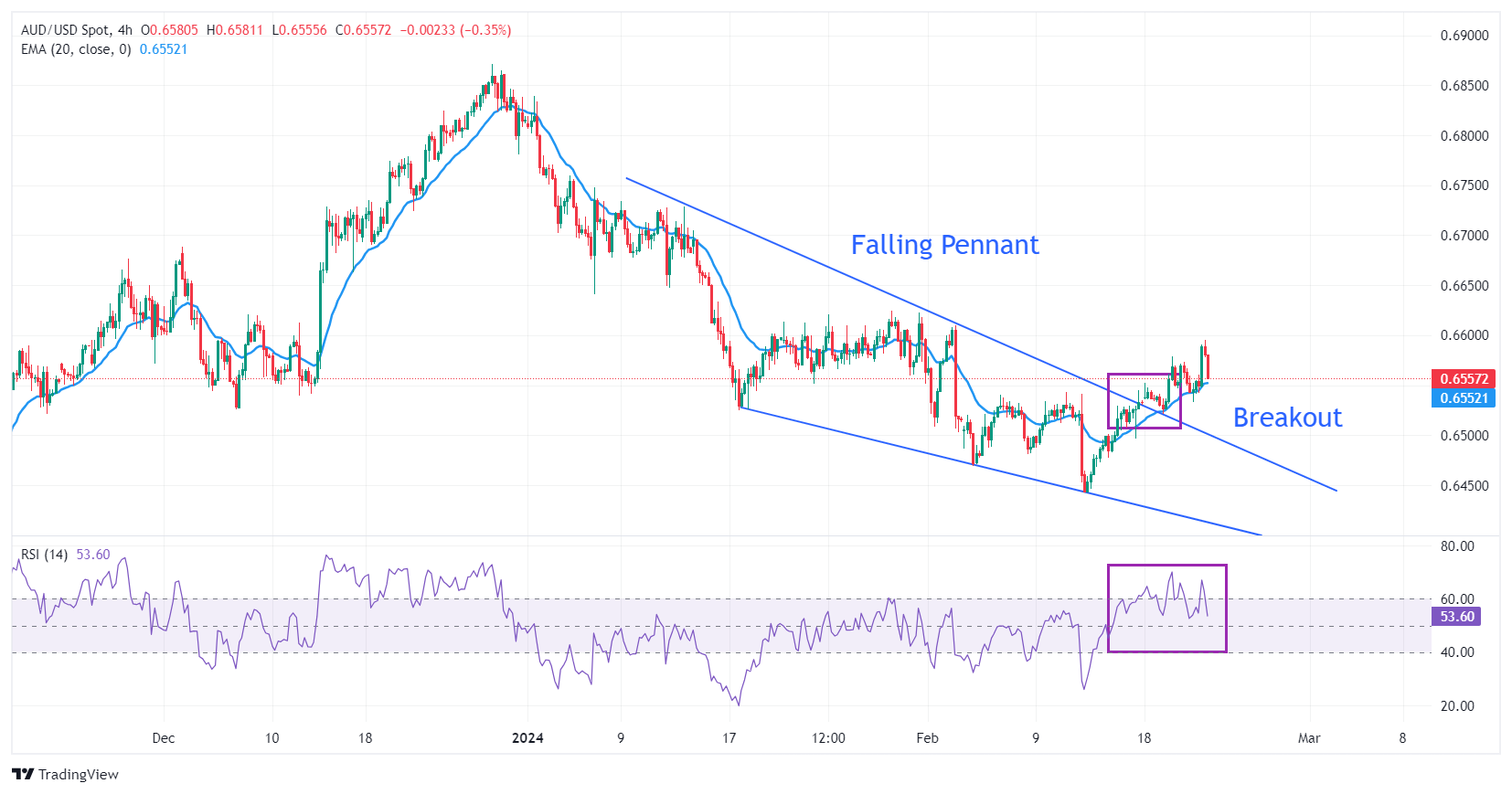- AUD/USD falls vertically from 0.6600 as the US Dollar gets a firm footing.
- Deepening geopolitical tensions have improved safe-haven appeal.
- Fed policymakers are less likely to cut interest rates soon.
The AUD/USD pair falls sharply after a steep rally to the round-level resistance of 0.6600 in the early New York session on Thursday. The Aussie asset faces a sell-off as the US Dollar has rebounded amid deepening Middle East tensions.
The Israeli army has intensified bombarding on Rafah, the southern region of Gaza in Palestine, as the former hopes that over 1.4 million refugees have been sheltered there. Escalating Middle East tensions have improved the appeal for safe-haven assets.
Meanwhile, the Federal Open Market Committee (FOMC) minutes for January’s policy meeting indicated that policymakers don’t want to cut interest rates early amid lack of conviction on the progress in inflation declining to the 2% target.
The Australian Dollar remains bullish lately as the Reserve Bank of Australia (RBA) minutes for February policy meeting indicated that policymakers were interested in raising the Official Cash Rate (OCR) further. It indicates that the current monetary policy of the RBA is not sufficiently restrictive to tame sticky price pressures.
Going forward, investors will focus on the United States preliminary S&P Global PMI data for February, which will be published at 14:45 GMT.
AUD/USD strengthens after a breakout of the Falling Pennant chart pattern formed on a four-hour scale. A breakout of the aforementioned pattern indicates a bullish reversal. The breakout of a Falling Pennant happens when selling pressure dries, and investors consider it a value-buy.
The 20-period Exponential Moving Average (EMA) near 0.6550 continues to provide support to the Australian Dollar bulls.
The 14-period Relative Strength Index (RSI) struggles to sustain in the 60.00-80.00 region. A bullish momentum would trigger if the RSI (14) manages to do so.
Fresh upside would appear if the asset breaks above the round-level resistance of 0.6600, which will drive the asset towards January 30 high at 0.6625, followed by December 4 high at 0.6688.
In an alternate scenario, a downside move below February 15 low at 0.6477 would activate sellers and will expose the asset to February 13 low at 0.6443 and the round-level support of 0.6400.
AUD/USD four-hour chart
Information on these pages contains forward-looking statements that involve risks and uncertainties. Markets and instruments profiled on this page are for informational purposes only and should not in any way come across as a recommendation to buy or sell in these assets. You should do your own thorough research before making any investment decisions. FXStreet does not in any way guarantee that this information is free from mistakes, errors, or material misstatements. It also does not guarantee that this information is of a timely nature. Investing in Open Markets involves a great deal of risk, including the loss of all or a portion of your investment, as well as emotional distress. All risks, losses and costs associated with investing, including total loss of principal, are your responsibility. The views and opinions expressed in this article are those of the authors and do not necessarily reflect the official policy or position of FXStreet nor its advertisers. The author will not be held responsible for information that is found at the end of links posted on this page.
If not otherwise explicitly mentioned in the body of the article, at the time of writing, the author has no position in any stock mentioned in this article and no business relationship with any company mentioned. The author has not received compensation for writing this article, other than from FXStreet.
FXStreet and the author do not provide personalized recommendations. The author makes no representations as to the accuracy, completeness, or suitability of this information. FXStreet and the author will not be liable for any errors, omissions or any losses, injuries or damages arising from this information and its display or use. Errors and omissions excepted.
The author and FXStreet are not registered investment advisors and nothing in this article is intended to be investment advice.
Recommended content
Editors’ Picks
EUR/USD stays in positive territory above 1.0850 after US data

EUR/USD clings to modest daily gains above 1.0850 in the second half of the day on Friday. The improving risk mood makes it difficult for the US Dollar to hold its ground after PCE inflation data, helping the pair edge higher ahead of the weekend.
GBP/USD stabilizes above 1.2850 as risk mood improves

GBP/USD maintains recovery momentum and fluctuates above 1.2850 in the American session on Friday. The positive shift seen in risk mood doesn't allow the US Dollar to preserve its strength and supports the pair.
Gold rebounds above $2,380 as US yields stretch lower

Following a quiet European session, Gold gathers bullish momentum and trades decisively higher on the day above $2,380. The benchmark 10-year US Treasury bond yield loses more than 1% on the day after US PCE inflation data, fuelling XAU/USD's upside.
Avalanche price sets for a rally following retest of key support level

Avalanche (AVAX) price bounced off the $26.34 support level to trade at $27.95 as of Friday. Growing on-chain development activity indicates a potential bullish move in the coming days.
The election, Trump's Dollar policy, and the future of the Yen

After an assassination attempt on former President Donald Trump and drop out of President Biden, Kamala Harris has been endorsed as the Democratic candidate to compete against Trump in the upcoming November US presidential election.
